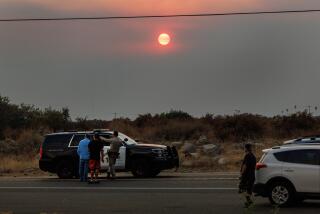How About a Smog Observance Day in Los Angeles?
On Sept. 13, 1955, Los Angeles endured its smoggiest day in history. Ozone levels hit a record peak, and the city prepared to shut itself down. Only three years earlier, 3,000 people in London had died during a “killer fog.”
Smog may not seem like anything to celebrate, but I propose we establish a Smog Observance Day so that we never forget how close Southern California came to self-asphyxiation. While far from perfect now, the air has grown dramatically more breathable since the fall of 1955, even as the region’s population has tripled and the number of vehicles has quadrupled. Progress is possible. Problems can be solved. Let’s party! The lead car in the Smog Day parade can be electric and the guests of honor can be the catalytic converter, reformulated gas, the gas hose nozzle sleeve, the unpopular Smog Check program and a patchwork of other rules and regulations that have finally paid off.
For the record:
12:00 a.m. Sept. 17, 1998 For the Record
Los Angeles Times Thursday September 17, 1998 Home Edition Metro Part B Page 9 Metro Desk 1 inches; 23 words Type of Material: Correction
Smog--The worst recorded smog day in L.A. was Sept. 13, 1955, which was 43, not 33, years ago. A subheadline on Daniel Nussbaum’s article on Monday was incorrect.
Two months before the unnerving mid-September episode in 1955, the Air Pollution Control District, forerunner of today’s Air Quality Management District, had announced rules for the nation’s first smog emergency program. Lenient to a fault, it called for a ban on most backyard trash burning and a “request” for the public to suspend unnecessary driving when ozone reached an extremely grimy .5 parts per million of air.
With air that bad, people report burning eyes and painful breathing; biochemical changes in the body produce components that can cause acute lung damage; hospital admissions and emergency room visits soar. Even so--picking up a theme that repeats throughout smog history--one manufacturer’s group whined, “The law will affect the good name and economy of the Los Angeles area.”
Under today’s rules, a significantly lower level, .35 ppm, triggers a second-stage smog alert, which calls for mandatory car-pooling, a ban on outdoor activity by children at schools and an option for the governor to declare a state of emergency. But in the mid-’50s, when official monitoring began, draconian measures would be enforced only when levels reached a shocking 1.0 ppm. On Sept. 13, 1955, they came close. At 10:23 a.m., the ozone level leaped to .56 downtown--the equivalent of a third-stage alert today, something that has happened only once, in 1976, in the Inland Empire. Soon officials would report .85 downtown and .90 in Vernon, the highest level ever recorded before or since.
Smith Griswold, head of the APCD, summoned the Board of Supervisors and a committee of business and industry leaders to a tense meeting. The deputy county counsel reminded supervisors that the county sheriff could wield almost unlimited powers under the looming state of emergency. The road commissioner reported that he had 1,200 barricades ready to fulfill Griswold’s pending order to blockade all freeways leading into downtown. Inspectors waited at oil refineries for the go-ahead to shut them down.
Gov. Goodwin Knight, speaking by phone from Sacramento, told the group, described as “solemn and red-eyed,” that he had the California Disaster Committee on alert. A news photo from that day shows street lights burning in the haze at Sixth and Olive streets. It is 11 a.m.
Around 1 p.m., an 8 mph breeze blew in from the west. The ozone reading fell. A half-hour later, officials canceled the alert.
In the day’s gloom, Griswold predicted that ozone would go above the dreaded 1.0 ppm level that year and that L.A. would have a full-blown emergency. Instead, Sept. 13 marked the low point in L.A.’s ongoing air quality crisis, largely because measures already in place began to take effect. Even Angelenos who lived through the bad air days of the ‘60s and ‘70s seldom realize just how much worse smog had been at its onset. In 1949, one late season onslaught persisted for a depressing 17 days, with a day off for Thanksgiving. In October 1954, that year’s worst siege set off mass meetings in Pasadena, with its mayor advocating “radical” economic changes. Downtown, pedestrians buried their faces in handkerchiefs and motorcycle messengers went on strike until their boss provided gas masks.
At the height of the clamor, Knight flew to L.A. to hear a panel of experts tell him that the smog menace was overrated because, as one expert said, “We haven’t had people faint or drop dead on the streets.”
We need a Smog Day, and not just to remind us of the fallibility of experts. We need one to remind us not to get too self-congratulatory. In spite of the progress, the region still has the dirtiest air in the nation. But every Sept. 13, we might think about how bad off we’d be if in 1955 the air had grown worse and not better.
More to Read
Sign up for Essential California
The most important California stories and recommendations in your inbox every morning.
You may occasionally receive promotional content from the Los Angeles Times.










